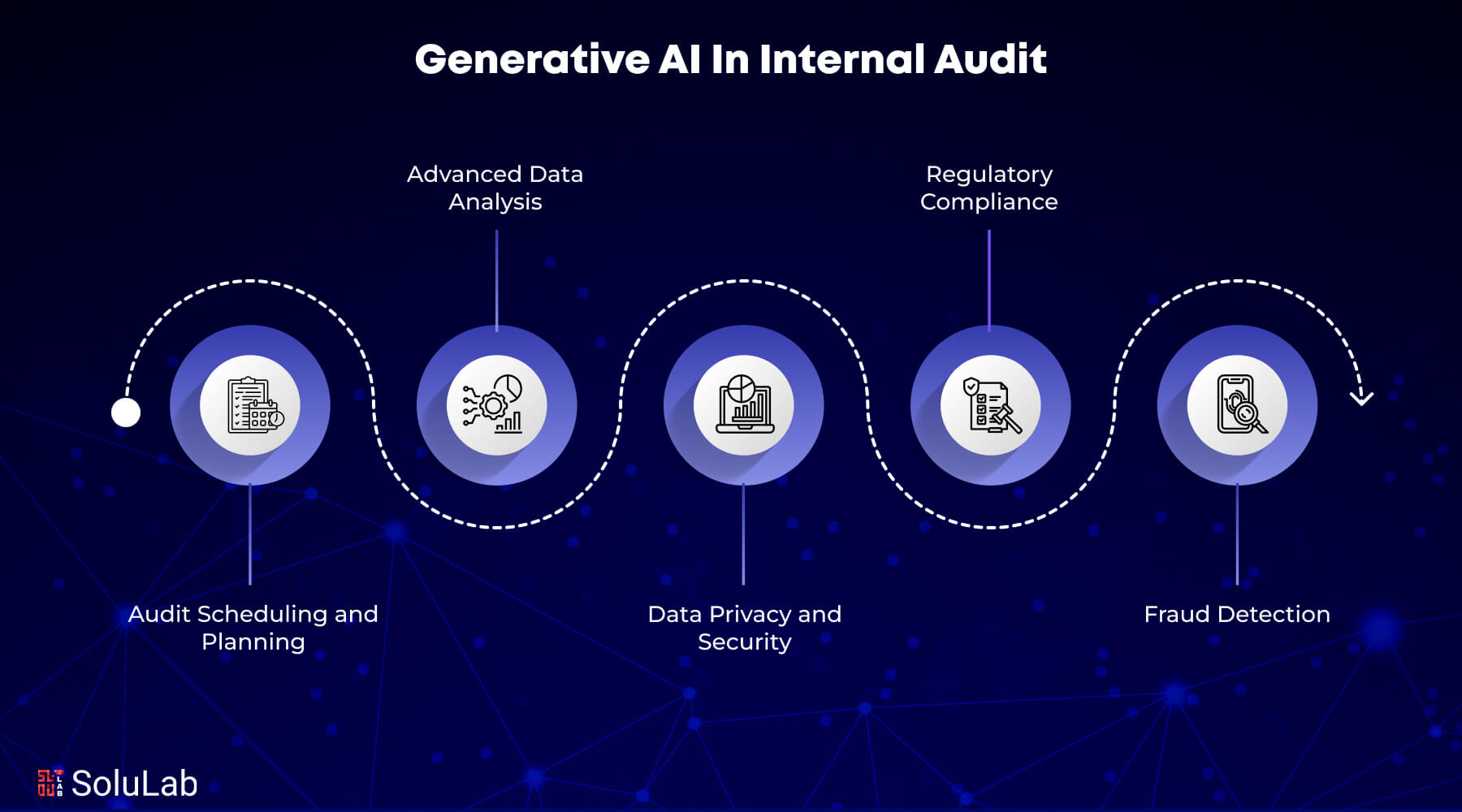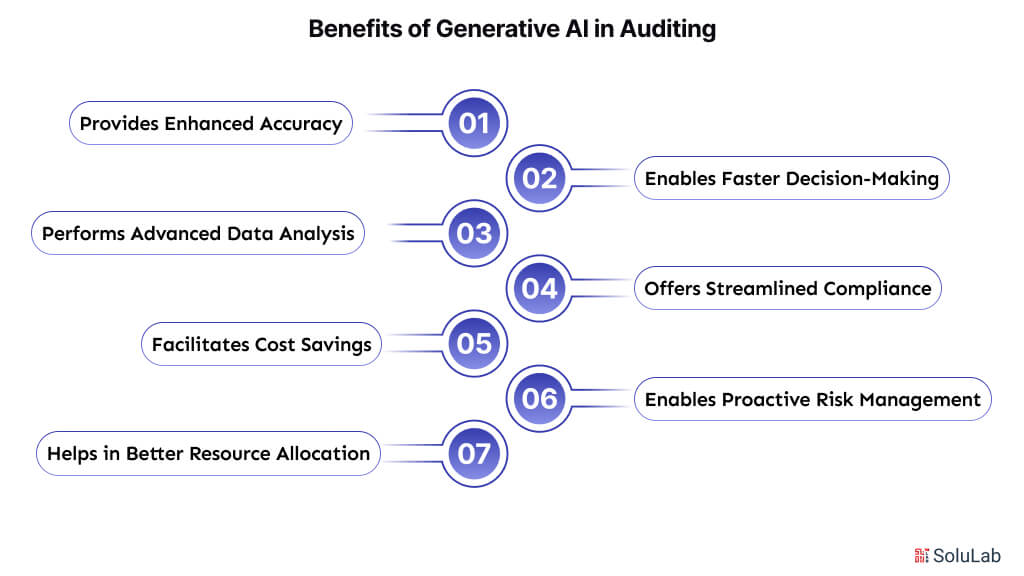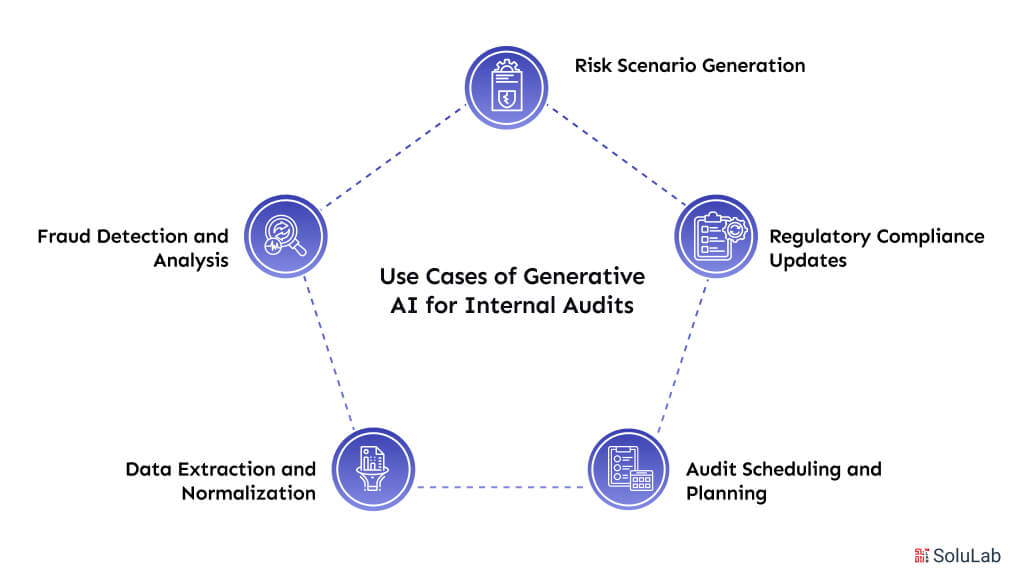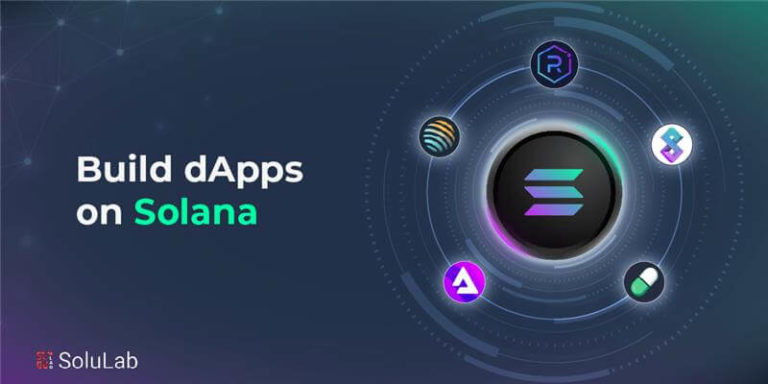
Generative AI (GenAI) in internal audit (IA) is taking the field to the next level by changing how organizations handle risks, maintain compliance, and carry out effective operations. Previously, internal audits had always been considered tedious tasks, since auditors had to manually analyze huge amounts of data. Now, consider having these data analyzed within seconds, hidden patterns identified immediately, and insightful reports generated without breaking a sweat. This is not just a possibility but is the actual way how generative AI transforms internal audit.
According to a Gartner survey, forty-one percent of chief audit executives (CAEs) have already begun using generative AI in internal audits or intend to use it this year. In a survey comprising 112 CAEs, 12% of them informed that their department had already implemented generative AI models, namely, OpenAI GPT, Google Bard, and others. Another 29% of them were planning to implement the technology by next year, and 20% of them were considering adopting it over a longer period. This widespread adoption of generative AI in various sectors highlights the capability of this technology to transform the efficiency and scope of this internal audit field globally. So, without much ado, let us find out more about generative AI in internal audit.
What is Generative AI in Internal Audit?
Generative AI is nothing but an advanced artificial intelligence (AI) technology that can identify the patterns in training data and generate outputs. It uses deep-learning models and provides results, including texts, images, and videos, learned from patterns. Hence, generative AI can produce more content than conventional machine learning methods. You can find that the interpretations in this technology will be much more detail-oriented and the responses personalized according to various inputs.
Generative AI in internal audits assists in regulating the audit process. It also helps to improve its efficiency and accuracy. The various methods for which this technology is used include text-text to create audit reports, and text-data to analyze risk assessments from raw data. This helps the auditors to interpret complex datasets into relevant information swiftly. You can also enhance the efficiency of the audit workflow with generative AI, as it allows audit trails, compliance reports, and risk management documentation to be automatically generated.
Why is Generative AI Vital in Internal Audits?
Ensuring an organization’s ethical standards and compliance is a complicated process because global regulations and business environments develop constantly. Internal auditing plays a significant role in attaining this. As the business and regulatory norms expand, auditors face the huge challenge of navigating enormous amounts of data and they have to be accurate in their evaluation.
Generative AI in internal audit makes this easier by automating these tasks including data analysis, compliance monitoring, and risk assessment. Hence, this increases the accuracy and speed of audits and auditors can concentrate more on strategic actions rather than mundane tasks. This technology also facilitates dynamic risk modeling and real-world decision-making. These two features are vital for proactive risk management and regulatory compliance.
Functioning of Generative AI in Internal Auditing
Generative AI learns from huge datasets, identifying patterns and structures to anticipate and create new content. This can prove helpful for tasks that require creativity or a variety of responses. Examples of such tasks include drafting content or summarizing data. Speaking of outputs, they may vary according to the queries.
The outputs of generative AI are not similar to conventional deterministic tools. They are based on probabilities. So, the same query can give you different results every time.
Also, generative AI is often dependent on foundation models. Organizations can utilize this model without any modifications. However, if they want to customize the model with data to meet specific requirements, it can impact the data’s transparency and traceability.
Regardless of these challenges, you can witness how GenAI improves audit accuracy and efficiency significantly when it is incorporated into internal audit functions. It automates mundane tasks and analyzes complex data so that auditors can concentrate on important strategic activities and improve the quality of the audit.
Benefits of Generative AI in Auditing

Leveraging generative AI in internal audit can help increase efficiency in various areas and is advantageous in many ways. Let us examine them:
1. Provides Enhanced Accuracy: Generative AI reduces the possibility of human error in data processing and analysis. Hence, you can find the audit results to be more accurate.
2. Enables Faster Decision-Making: Generative AI provides real-time insights to auditors which enables them to make quick informed decisions. This is very much needed for effective risk management.
3. Performs Advanced Data Analysis: Generative AI can analyze enormous amounts of data, recognizing trends and anomalies that can be missed manually.
4. Offers Streamlined Compliance: Generative AI for compliance audits automates the compliance process which helps in ensuring that the regulations are met. This reduces the risk of violating policies and avoids the penalties associated with them.
5. Facilitates Cost Savings: Generative AI audit automation can help to decrease the time dedicated to audits, thereby facilitating significant cost savings in the auditing process.
6. Enables Proactive Risk Management: Generative AI tools can recognize potential risks way- ahead which helps the organizations to take proactive steps even before the issue begins.
7. Helps in Better Resource Allocation: Generative AI automation can regulate routine tasks. Hence, audit teams can utilize their resources effectively by allocating them to work on strategic and high-risk areas.
Various Methods to Integrate Generative AI in Internal Audits
Organizations can incorporate generative AI into their internal audit functions in various methods, with each offering its advantages. Of them, there are several common strategies. Developing a customized in-house AI solution is one of the methods you can adopt in your organization. In this method, you can develop an AI system from the beginning, or customize the existing models according to your requirements. By doing so, you have the advantage of your AI model aligning with your organization’s specific auditing needs and workflows. You can also have full control over data privacy and model training. This ensures that your entire processes comply with regulatory requirements.
Another method is to use GenAI point solutions. Here, you can utilize standalone AI applications, integrated into the existing software systems to perform particular tasks including compliance checks. The advantage of using this method is that they are designed to execute specific tasks effectively. Hence, you can meet your targeted requirements within the audit. The tools are also very user-friendly, so you can easily adopt them in your organization. When you integrate these solutions into your existing audit processes, it enables swift operational use.
Use Cases of Generative AI for Internal Audits

Let us examine the generative AI use cases for internal audits:
Risk Scenario Generation:
Unlike traditional risk management models, generative AI can create dynamic scenarios. It uses huge datasets and complex algorithms to generate potential risk scenarios effectively. Generative AI for audit risk management also helps in risk analysis by giving detailed insights into risk factors. This helps the auditors anticipate various outcomes by assessing current and historical information.
It also provides narrative explanations of these potential risks and helps the organization to understand them and strategize more effectively. This technology warns well in advance about potential future challenges by analyzing long-term data on emerging risk trends.
Regulatory Compliance Updates:
It can be a tedious task to stay updated with the changing regulatory compliances manually. Generative AI simplifies this process by automating the monitoring and reporting of updates in compliance. This greatly reduces the manual labor involved in administration and improves the precision of compliance practices. It continuously monitors the global regulatory feeds and provides an overview of the changes and actions to be done.
Generative AI also automatically compares new regulations with existing ones, and if there are any variations or gaps, it highlights them. Hence, audit practice adjustments can be done immediately. It also provides detailed compliance action insights, highlighting the nature of the adjustments according to the severity and the time range – whether immediate actions are required. Hence, you can achieve effective compliance management.
Audit Scheduling and Planning:
Generative AI outperforms traditional audit planning methods by improving the flexibility and efficiency of audit planning. It utilizes advanced analytics to evaluate risks and optimize audit schedules. With the help of real-time data and insights, it dynamically adjusts the audit schedules, enabling the audits to work on the most relevant and urgent matters that require attention.
Generative AI also helps in allocating resources effectively by automating regular tasks and reducing redundancy. It also provides suggestions after analyzing historical data and recent trends for audits to focus on.
Data Extraction and Normalization:
When you handle huge amounts of data manually, it will be highly time-consuming and can also lead to errors. When generative AI is used for this process, it can automate them and improve their accuracy and effectiveness. It automatically extracts data from various sources, which ensures a complete audit trail. Simple and accurate data analysis is possible since it uses normalization techniques across different data formats and creates a standardized dataset.
Generative AI also integrates and synthesizes data from different sources into a standardized format and makes it prepared for audit analysis. It minimizes the complexities related to disparate data sources. It also adds context and extra layers of information to the extracted data which helps in analyzing the data more deeply and understanding it well during the audit process.
Fraud Detection and Analysis:
Generative AI provides more stringent measures against fraudulent activities than traditional methods. This is because this technology improves pattern recognition and anomaly detection abilities. It automatically generates complete reports with detailed information about the fraudulent activities discovered, possible weaknesses, and the preventive measures to be taken. This can strengthen the ongoing efforts taken to prevent deceitful activities.
It also processes real-time data to constantly update and improve fraud detection mechanisms, which ensures that the system can adapt to new and upcoming fraud tactics.
Read Also: Top Generative AI Development Companies
What Are the Challenges Involved in Adopting Generative AI For Internal Audits?
Adopting generative AI in internal audit functions can prove advantageous in various ways. However, there are some challenges involved in this process that require strategic management and careful consideration. Let us examine more about them.
1. Governance and Supervision: You have to ensure a vigorous framework is established for managing and supervising generative AI applications. This is necessary to ensure that they act according to your organization’s goals and compliance requirements. If the technology is not managed properly, it can result in inefficient functioning and non-adherence to ethical standards. Also, in cases of poor governance, there are possibilities for this generative AI technology to be applied inconsistently which can result in unreliable audit outputs and potential regulatory audits.
2. Regulatory Compliance: Since the regulatory environments keep changing, the generative AI technology should also adapt accordingly. To ensure this, you have to constantly update and check that all processes leveraging generative AI comply with the regulatory requirements. If any non-compliance with regulations is identified, then your organization can be subjected to legal penalties and loss of trust among stakeholders. Hence, generative AI should adhere to legal compliances without fail.
3. Knowledge and Skills: To effectively deploy and manage generative AI, particular technical skills and understanding are required which traditional audit teams may miss out on. This skill gap needs to be addressed so that generative AI can be leveraged completely. If there is not enough expertise, audit teams may not be able to successfully integrate generative AI tools efficiently, which may result in the technology not being used to its full potential and some audit insights may be neglected.
4. Fraud Identification and Management: Fraud detection algorithms need to be constantly monitored and updated to avoid misuse of generative AI technology. When this technology detects and manages fraudulent activities effectively, it increases the reliability and credibility of the audit processes. Even a slight failure can affect the performance of the audit and the financial security of your organization.
5. Data Privacy and Security: Cyber threats are one of the major concerns that generative AI systems have to encounter as they process and store vast amounts of sensitive data. You have to implement robust security mechanisms to prevent such data hacks. If there are any compromises in this area, it can damage both your organization’s financial status and reputation.
6. Ethical Implications: Generative AI must be developed and used for appropriate purposes to prevent any biases or harm. To achieve this, you have to ensure that the training data is diverse, and the algorithms are fair and transparent. In case of any ethical mishandling in generative AI, it can result in public backlash and loss of trust among stakeholders. Hence, audit functions need to rigorously follow ethical AI practices to ensure they are credible and effective.
Best Practices to Write Generative AI Prompts
It is well-known that AI audit prompts are capable of transforming workflows. However, it is noteworthy that the responses they provide have variable accuracy. Hence, you have to give specific prompts and use AI outputs at the beginning instead of using them at the end. This can ensure reliability. You can consider the tips below while developing a generative AI audit prompt.
- Be Specific: When using generative AI for audit prompts, you have to be specific about the audit area, whether it is compliance or risk. You also have to specify the scope (i.e. key risks, or audit findings), the intended format (summary report, or detailed analysis), and the tone. With all these specifications, you can be assured that the AI responses will be aligned with your audit objectives.
- Provide Context: To get precise answers from generative AI, you have to always provide the background information or context relevant to your audit scope or organization. If you want information on regional regulatory requirements, you can mention the same, so that AI can customize responses accordingly.
- Focus on a Single Query: The response of generative AI will be better when it responds to a single query at a time. Hence, if you require multiple questions to be answered, ask them one after the other. For instance, if you need answers about risk assessment, and compliance simultaneously, ask about risk assessment first, and then proceed to the next question. You can then receive accurate answers.
- Brainstorm: If you require creative answers from generative AI, you can command it to brainstorm potential audit risks. You will receive unique responses that might not be possible with conventional audit methods.
- Experiment: If you are not satisfied with an answer the generative AI provides, you can experiment further. Try asking the prompt differently or provide additional information. This way, you may receive more relevant audit insights.
Future of Generative AI in Internal Audits
The adoption of generative AI into internal audit functions is all set to change the audit processes in the best way. Generative AI outputs are complex and humans alone cannot verify them independently. Hence, the growth of audit procedures is required. Let us examine a few key trends that are anticipated to shape the future of internal audit functions through generative AI technology.
- Improved Real-Time Analytics: With the generative AI technologies developing, they will enable advanced real-time analytics. Due to this, auditors can quickly and precisely discover and address risks, thereby changing the conventional audit cycles into more dynamic and constant processes.
- Complete Automation of Regular Activities: Generative AI will completely automate mundane and time-consuming tasks including risk assessment, data collection, and compliance checks. This transformation will enable the auditors to concentrate on more strategic and pressing issues involved in the audit process.
- Shift Towards Advisory Functions: With the regular tasks being automated, auditors can slowly shift towards advisory functions. They can use the insights that generative AI provides and offer strategic guidance to stakeholders. This can improve the overall value of the audit process.
- Skills Upgradation: Auditors have to upgrade or develop new skills, specifically in technology, and data analysis so that they can utilize generative AI tools efficiently. Constant learning and adaptation are vital for staying active in this audit field.
- Uphold Ethical and Regulatory Compliance: As the adoption of generative AI increases, so does the emphasis on upholding ethical and regulatory compliance, especially when it comes to data usage and privacy. Auditors are the key persons who can ensure this happens.
- Integration Challenges: You can encounter certain challenges while integrating generative AI, including handling changes within the organization and ensuring that all employees undergo appropriate training. However, it also provides outstanding opportunities to enhance the efficiency and effectiveness of the audit processes.
The Bottom Line
The integration of generative AI in internal audit functions can undoubtedly change the audit processes into a much more effective one. This technology will continue advancing, thereby offering numerous opportunities to improve the accuracy of audit practices. For instance, generative AI in the supply chain has become a huge success. Also, you can collaborate with generative AI development companies to help your organization to adopt this technology effectively.
ShopSmart, a major retail company is converting the shopping experience with innovative AI-driven solutions. It provides a range of services from customized recommendations to automated inventory management. It is also at the forefront of incorporating generative AI to optimize operations and take customer satisfaction to the next level.
SoluLab, a leader in generative AI development company, uses outstanding AI technologies to develop innovative solutions that transform businesses across different industries. They have good expertise in generative artificial intelligence that helps them present innovative generative AI applications, which satisfy the client’s requirements. Contact us now at SoluLab and explore the various outstanding solutions provided.
FAQs
1. How can generative AI be used in audit?
Generative AI can be used in audits to analyze vast amounts of financial data to discover patterns, anomalies, and inefficiencies. It can automate regular tasks and allow auditors to concentrate more on strategic insights. It can also enhance the decision-making process which is vital for proactive risk management and regulatory compliance.
2. What is the future of AI in auditing?
AI has the potential to change the auditing processes. It can be used efficiently when you understand its capabilities and use it to the fullest extent. Once its limitations are also fully addressed, it can be integrated into the audit functions, thereby enhancing its accuracy and efficiency while obtaining more relevant insights.
3. How generative AI can be used in business?
Generative AI can be utilized in business in many ways including fraud detection, customer service, supply chain, and others. In fraud detection, this technology can analyze huge volumes of data to identify any fraudulent activity in financial transactions. Whereas, generative AI in customer service can provide better support by offering customized responses.
4. How might AI change auditing and accounting services?
AI can automate regular tasks including data entry, risk assessment, and regulatory compliance. This transformation will enable the auditors to concentrate on more strategic and pressing issues involved in the audit process. Another advantage is that it allows professionals to gain more in-depth knowledge in crucial areas of auditing.
5. How to use generative AI in accounting?
Generative AI tools can be trained to identify patterns in financial data. When there is any deviation from the recognized patterns, these tools can identify them as potential indicators of fraud. This real-time analysis helps accountants and auditors take quick counteractive measures when something doesn’t seem to fit the context.






